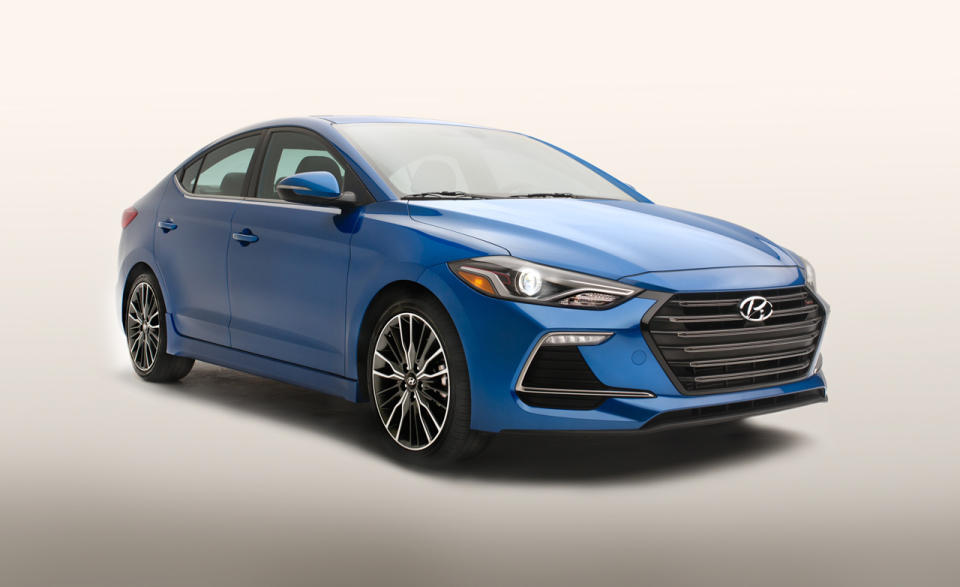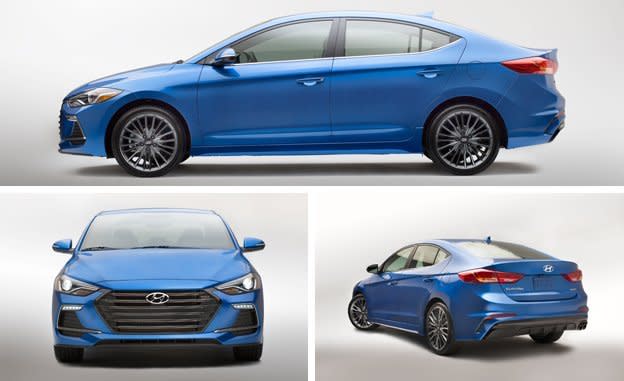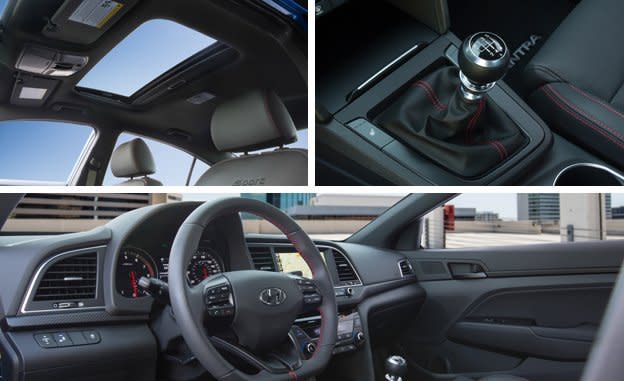2017 Hyundai Elantra Sport

After a foreign-market tease, where the U.S.-market Elantra’s Korean twin gained a turbocharged Sport model earlier this year, Hyundai has finally unveiled the Sport headed for our shores. As you’d expect, just as our Elantra sedan is the same as the Korean-market Avante, our Elantra Sport is pretty much the same as the Avante Sport, and that’s exciting news if you’ve been eagerly waiting for a sportier Elantra.
We’re not sure how many buyers are holding their breath for an Elantra with an injection of extra spice, but the Sport will slide in just below the hottest compacts, cars such as Volkswagen’s GTI, Honda’s forthcoming next-gen Civic Si, and Ford’s Focus ST. Okay, yeah, the Veloster Turbo is a sport-compact Hyundai already available to U.S. customers, but it’s weird-looking, has asymmetrical doors, and isn’t very good to drive.

The 2017 Elantra Sport is decidedly non-weird-looking—it is actually quite handsome. Sharing its basic grille shape and headlights with other Elantras, the Sport gets deep cuts underneath each cheekbone, a subtle body kit, and attractive 20-spoke aluminum wheels. In what counts as a design coup, Hyundai resisted the urge to sprinkle boy-racer spoilers and flashy bits over the Sport, skipping an extroverted, Focus ST–style aesthetic for a subtler, more mature GTI-like vibe. The theme continues inside with red contrast stitching, a flat-bottom steering wheel, and sport seats.
Hyundai backs up the Sport’s sporting visuals with what appear to be sporting mechanicals, at least on paper. The regular Elantra’s 2.0-liter four-cylinder engine is chucked in favor of Hyundai’s turbocharged, direct-injected 1.6-liter four-cylinder producing “more than” 200 horsepower and 190 lb-ft of torque. Specific power figures will be released closer to the Sport’s on-sale date later this year, but the model’s preliminary numbers are nonetheless 53 horsepower and 58 lb-ft stronger than those assigned to the base 2.0-liter engine—although they will trail those of the aforementioned segment heavyweights, all of which use 2.0-liter turbocharged fours. It is worth noting that the Sport won’t be the only turbocharged Elantra—the fuel-economy-oriented Eco has a 128-hp 1.4-liter turbo four—but it will be the mightiest.
Doing its part to Save the Manuals, Hyundai will offer a six-speed manual transmission in addition to a seven-speed dual-clutch automatic with paddle shifters. The Sport remains front-wheel drive, but its rear end is overhauled and now has a multilink independent suspension. Replacing the non-Sport Elantra’s twist-beam axle, the new suspension design should offer more controlled dynamics, and we’d wager it will add further refinement to the Elantra’s ride while enhancing individual wheel discipline over bumps.

We have our fingers crossed that Hyundai’s tuning mavens were able to tamp down the Elantra’s wandering steering and button down the chassis for this Sport model, as it would finally give us adjectives beyond “comfortable” and “stylish” to describe the Elantra lineup. Having mastered nearly every other aspect of building affordable, desirable cars, Hyundai is still learning when it comes to driving dynamics—and a lack of fun is all that held the Elantra back against the sportier Honda Civic and Mazda 3 in our most recent small-car comparison test.
If there’s anything the Elantra Sport is missing—besides final pricing, specifications, and us in the driver’s seat—it’s a hatchback body style. Scan today’s warmed-up compacts, and it’s clear that hatchbacks dominate, leaving the four-door Elantra Sport (and its trunk) sticking out. That said, Honda’s next Civic Si is likely to arrive as a sedan and a coupe in addition to a hatch, Nissan is working on a turbocharged Sentra NISMO sedan, and Volkswagen continues to offer the Jetta GLI, so perhaps compact sports sedans are making a comeback.

 Yahoo Autos
Yahoo Autos 